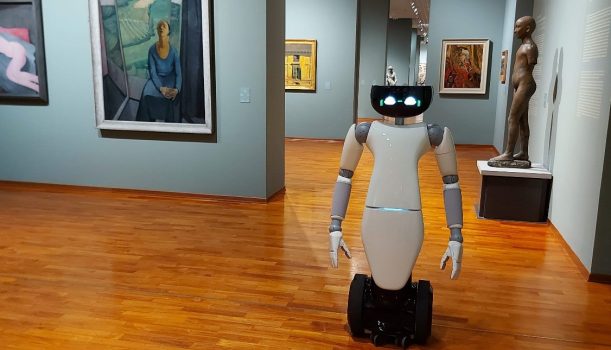Last week we brought the IIT (Istituto Italiano di Tecnologia) humanoid robot R1 at the GAM (Galleria d’Arte Moderna) in Turin to perform the first trial activities in the real environment. Indeed, after several weeks of experiments in a simulated environment, this was the first time that the robot was asked to autonomously navigate in the real museum.
During the experimental session we tested two 5G-TOURS scenarios: the teleoperation/remote surveillance use case (UC2c) and the robot-assisted guided tour (UC3). This second use case was especially complex, since involved the integration of a lot of different software components developed by different teams. Such components included: the autonomous navigation and path planning system; the localization algorithm, responsible for estimating the robot position in a map, (previously built using the robot’s lidar); the behavior tree, which was controlling and synchronizing the robot actions; the dialogue system. The latter was in charge of describing the artworks where the robot was stopping by and answering to the visitors’ questions. Together with Fondazione Torino Musei, we chose a selected number of relevant artworks and we tested the robot movements in several rooms of the museum even if presence of visitors, which were accidentally occluding the path of the robot. It was amazing to see the robot behave like a museum guide, describing the paintings and answering to questions such as the historical period in which the artwork was done.
Of course, this was just a preliminary test. The robot was connected to a standard wi-fi connection, and we also observed several non-correct behaviors. During the trials, we recorded a large dataset of sensory measurements obtained from the robot, in order to continue the development of the application in the lab, with a better comprehension of robot behavior in the final scenario.
The next activities will focus on the improvements of the robot capabilities and the definition of the dialogue templates. We are also planning additional tests in the Ericsson labs in Genoa using the 5G network, in preparation to the next trial in Turin (currently planned in autumn 2021). In this session we will test a more advanced scenario in which the robot will be connected to the ad-hoc 5G mobile network that TIM and Ericsson will deploy to provide indoor coverage of the museum.


